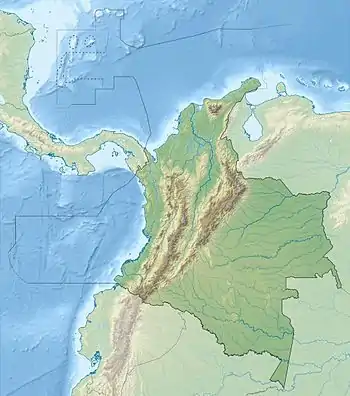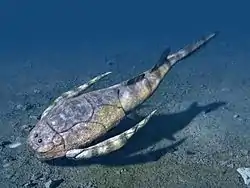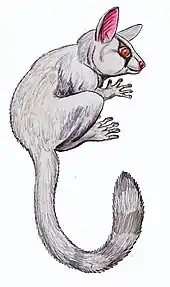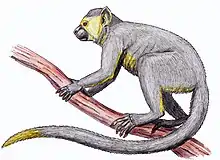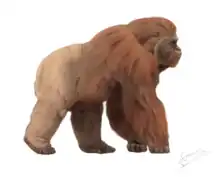| Cebupithecia | |
|---|---|
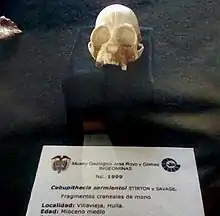 | |
| Reconstructed skull | |
| Scientific classification | |
| Domain: | Eukaryota |
| Kingdom: | Animalia |
| Phylum: | Chordata |
| Class: | Mammalia |
| Order: | Primates |
| Suborder: | Haplorhini |
| Infraorder: | Simiiformes |
| Family: | Pitheciidae |
| Subfamily: | Pitheciinae |
| Genus: | †Cebupithecia Stirton & Savage 1950 |
| Species | |
| |
Cebupithecia is an extinct genus of New World monkeys from the Middle Miocene (Laventan in the South American land mammal ages; 13.8 to 11.8 million years ago). Its remains have been found at the Konzentrat-Lagerstätte of La Venta in the Honda Group of Colombia. The type species is C. sarmientoi.[1][2]
Description
Fossils of Cebupithecia were discovered in the "Monkey Beds" of the Honda Group, that has been dated to the Laventan, about 13.5 million years ago. Cebupithecia had a dental formula of 2:1:3:3 on the lower jaw. The incisors of this species were procumbant, suggesting a close relation to Pithecia.[3] and the canines had a stout appearance. The molars were flat with cusps having little contours.[2] Cebupithecia had an estimated average body mass around 1,602 g (3.532 lb).[4] Cebupithecia had a relatively longer talar neck and a higher, more squared-shaped talar body. In these features, Cebupithecia is more like cebines or aotins than pitheciines, but its overall pattern is unlike any living platyrrhine group or any of the known fossils.[5]
Movement
Cebupithecia also exhibits a relatively large medial protuberance, which is smoothed, another resemblance to aotins. The significance of these characteristics is difficult to interpret. Cebupithecia may be the most primitive known pitheciine, retaining shared primitive resemblances with aotins and cebines. Alternatively, its unusual morphology could reflect a unique, derived (for pitheciines) locomotor pattern. The talar features that distinguish Cebupithecia from other pitheciines indicate that leaping was relatively more frequent, as is also indicated by other postcranial features. The locomotor behavior of Cebupithecia has been reconstructed as frequent quadrupedalism and leaping,[5] or more relying on vertical clinging and leaping rather than quadrupedal locomotion, much like members of the extant genus Pithecia, to which the genus is related.[2][6]
Later research suggests that Cebupithecia may have employed its tail differently from most nonprehensile-tailed platyrrhines living today, behaviors that possibly involved tail-bracing or twisting during hindlimb (pedal grasping) suspensory behaviors. Such behaviors may serve as a preadaptive model for the full-fledged evolution of below-branch tail suspension and prehensility seen in other New World primates.[7]
Evolution
The evolutionary split between Pitheciidae, of which Cebupithecia, and Callicebus, including Miocallicebus, also found in the Honda Group, has been placed at 15.2 million years ago.[8]
Habitat
The Honda Group, and more precisely the "Monkey Beds", are the richest site for fossil primates in South America.[9] It has been argued that the monkeys of the Honda Group were living in habitat that was in contact with the Amazon and Orinoco Basins, and that La Venta itself was probably seasonally dry forest.[10] From the same level as where Cebupithecia has been found, fossils of Aotus dindensis, Micodon, Mohanamico, Saimiri annectens, Saimiri fieldsi, and Stirtonia tatacoensis have also been uncovered.[11][12][13]
See also
References
- ↑ "Cebupithecia sarmientoi". Fossilworks. Retrieved 26 March 2023.
- 1 2 3 "Cebupithecia sarmientoi". theprimata.com. 29 June 2007. Archived from the original on 7 April 2019.
- ↑ Defler, 2004, p.32
- ↑ Silvestro et al., 2017, p.14
- 1 2 Gebo et al., 1990, p.744
- ↑ Tejedor, 2013, p.28
- ↑ Organ & Lemelin, 2011, p.2013
- ↑ Takai et al., 2001, p.304
- ↑ Rosenberger & Hartwig, 2001, p.3
- ↑ Lynch Alfaro et al., 2015, p.520
- ↑ Luchterhand et al., 1986, p.1753
- ↑ Wheeler, 2010, p.133
- ↑ Setoguchi et al., 1986, p.762
Bibliography
- Defler, Thomas. 2004. Historia natural de los primates colombianos, 1–613. Universidad Nacional de Colombia. Accessed 2017-09-24.
- Gebo, Daniel L.; Marian Dagosto; Alfred L. Rosenberger, and Takeshi Setoguchi. 1990. New platyrrhine tali from La Venta, Colombia. Journal of Human Evolution 19. 737–746. Accessed 2017-09-24.
- Luchterhand, Kubet; Richard F. Kay, and Richard H. Madden. 1986. Mohanamico hershkovitzi, gen. et sp. nov., un primate du Miocene moyen d' Amerique du Sud. Comptes rendus de l'Académie des sciences 303. 1753–1758. Accessed 2017-09-24.
- Lynch Alfaro, Jessica W.; Liliana Cortés Ortiz; Anthony Di Fiore, and Jean P. Boubli. 2015. Special issue: Comparative biogeography of Neotropical primates. Molecular Phylogenetics and Evolution 82. 518–529. Accessed 2017-09-24.
- Organ, Jason M., and Pierre Lemelin. 2011. Tail Architecture and Function of Cebupithecia sarmientoi, a Middle Miocene Platyrrhine from La Venta, Colombia. The Anatomical Record 294.12. 2013–2023. Accessed 2017-09-24.
- Rosenberger, Alfred L., and Walter Carl Hartwig. 2001. New World Monkeys. Encyclopedia of Life Sciences _. 1–4. Accessed 2017-09-24.
- Setoguchi, Takeshi; Nobuo Shigehara; Alfred L. Rosenberger, and Alberto Cadena G. 1986. Primate fauna from the Miocene La Venta, in the Tatacoa Desert, Department of Huila, Colombia. Caldasia XV. 761–773. Accessed 2017-09-24.
- Silvestro, Daniele; Marcelo F. Tejedor; Martha L. Serrano Serrano; Oriane Loiseau; Victor Rossier; Jonathan Rolland; Alexander Zizka; Alexandre Antonelli, and Nicolas Salamin. 2017. Evolutionary history of New World monkeys revealed by molecular and fossil data. BioRxiv _. 1–32. Accessed 2017-09-24.
- Takai, Masanaru; Federico Anaya; Hisashi Suzuki; Nobuo Shigehara, and Takeshi Setoguchi. 2001. A New Platyrrhine from the Middle Miocene of La Venta, Colombia, and the Phyletic Position of Callicebinae. Anthropological Science, Tokyo 109.4. 289–307. Accessed 2017-09-24.
- Tejedor, Marcelo F. 2013. Sistemática, evolución y paleobiogeografía de los primates Platyrrhini. Revista del Museo de La Plata 20. 20–39. Accessed 2017-09-24.
- Wheeler, Brandon. 2010. Community ecology of the Middle Miocene primates of La Venta, Colombia: the relationship between ecological diversity, divergence time, and phylogenetic richness. Primates 51.2. 131–138. Accessed 2017-09-24.
Further reading
- Fleagle, John G., and Alfred L. Rosenberger. 2013. The Platyrrhine Fossil Record, 1–256. Elsevier ISBN 9781483267074. Accessed 2017-10-21.
- Hartwig, W.C., and D.J. Meldrum. 2002. The Primate Fossil Record - Miocene platyrrhines of the northern Neotropics, 175–188. Cambridge University Press, ISBN 978-0-521-08141-2. Accessed 2017-09-24.
